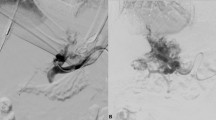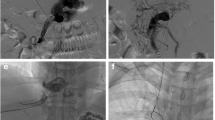Abstract
Objectives
To introduce a modified transjugular intrahepatic portosystemic shunt (TIPS) procedure, percutaneous transhepatic balloon-assisted TIPS (BA-TIPS), and to evaluate its feasibility and efficacy in patients with chronic totally occluded portal vein thrombosis (CTO-PVT) with symptomatic portal hypertension.
Methods
Eighteen patients (12 men, six women; mean age 49 years [range, 34–68 years]) with CTO-PVT with symptomatic portal hypertension undergoing BA-TIPS between July 2011 and June 2014 were enrolled in this retrospective study. Rates of technical success, efficacy, and complications were evaluated, and pre- and post-procedure portosystemic gradients compared. Clinical follow-up and periodic assessment of TIPS for patency were performed.
Results
BA-TIPS was successful in fourteen patients and converted to open portosystemic shunt placement in four. Mean portosystemic pressure gradient fell from 24.1 ± 2.3 mmHg to 12.1 ± 3.5 mmHg after BA-TIPS (P < 0.01). No procedure-related complications were observed. During a median follow up of 16 months (range, 3–41 months), there was one death from hepatocellular carcinoma, one death from severe heart disease, and shunt dysfunction 16 months after BA-TIPS in one patient. Shunt patency was maintained in the remaining patients without symptoms of recurrence.
Conclusions
BA-TIPS is feasible, safe, and effective for CTO-PVT with symptomatic portal hypertension.
Key Points
• Transjugular intrahepatic portosystemic shunt is an important treatment for portal vein thrombosis (PVT).
• TIPS is challenging for patients with chronic totally occluded portal vein thrombosis (CTO-PVT).
• The use of a balloon increased the technical success of portal puncture.
• Balloon-assisted TIPS (BA-TIPS) is feasible, safe, and effective for CTO-PVT.

Similar content being viewed by others
Abbreviations
- BA-TIPS:
-
Balloon-assisted transjugular intrahepatic portosystemic shunt
- CTO-PVT:
-
Chronic totally occluded portal vein thrombosis
- MPV:
-
Main portal vein
- PV:
-
Portal vein
- SMV:
-
Superior mesenteric vein
- SV:
-
Splenic vein
References
Nonami T, Yokoyama I, Iwatsuki S et al (1992) The incidence of portal vein thrombosis at liver transplantation. Hepatology 16:1195–1198
Belli L, Romani F, Sansalone CV et al (1986) Portal thrombosis in cirrhotics. A retrospective analysis. Ann Surg 203:286–291
Monarca A, Natangelo R, Tavani E et al (1986) Cirrhosis and portal vein thrombosis. Gastroenterology 90:509
Sogaard KK, Astrup LB, Vilstrup H et al (2007) Portal vein thrombosis; risk factors, clinical presentation and treatment. BMC Gastroenterol 7:34
Han G, Qi X, He C et al (2011) Transjugular intrahepatic portosystemic shunt for portal vein thrombosis with symptomatic portal hypertension in liver cirrhosis. J Hepatol 54:78–88
Qi X, Han G, Wang J et al (2010) Degree of portal vein thrombosis. Hepatology 51:1089–1090
Radosevich PM, Ring EJ, LaBerge JM et al (1993) Transjugular intrahepatic portosystemic shunts in patients with portal vein occlusion. Radiology 186:523–527
Van Ha TG, Hodge J, Funaki B et al (2006) Transjugular intrahepatic portosystemic shunt placement in patients with cirrhosis and concomitant portal vein thrombosis. Cardiovasc Intervent Radiol 29:785–790
Senzolo M, Tibbals J, Cholongitas E et al (2006) Transjugular intrahepatic portosystemic shunt for portal vein thrombosis with and without cavernous transformation. Aliment Pharmacol Ther 23:767–775
Mathieu D, Vasile N, Grenier P (1985) Portal thrombosis: dynamic CT features and course. Radiology 154:737–741
Walser EM, NcNees SW, DeLa Pena O et al (1998) Portal venous thrombosis: percutaneous therapy and outcome. J Vasc Interv Radiol 9:119–127
Chen S, Soares GM (2003) Balloon-targeted access of right portal vein for transluminal intrahepatic portosystemic shunt creation in the setting of portal vein thrombosis. J Vasc Interv Radiol 14:513–514
Jourabchi N, McWilliams JP, Lee EW et al (2013) TIPS placement via combined transjugular and transhepatic approach for cavernous portal vein occlusion: targeted approach. Case Rep Radiol 2013:635391
Garcia-Pagan JC, Hernandez-Guerra M, Bosch J (2008) Extrahepatic portal vein thrombosis. Semin Liver Dis 28:282–292
Manzanet G, Sanjuan F, Orbis P et al (2001) Liver transplantation in patients with portal vein thrombosis. Liver Transpl 7:125–131
Vianna RM, Mangus RS, Kubal C, Fridell JA, Beduschi T, Tector AJ (2012) Multivisceral transplantation for diffuse portomesenteric thrombosis. Ann Surg 255:1144–1150
Qi XS, Han GH (2012) Transjugular intrahepatic portosystemic shunt in the treatment of portal vein thrombosis: a critical review of literature. Hepatol Int 6:576–590
Luca A, Miraglia R, Caruso S et al (2011) Short- and long-term effects of the transjugular intrahepatic portosystemic shunt on portal vein thrombosis in patients with cirrhosis. Gut 60:846–852
Wils A, van der Linden E, van Hoek B, Pattynama PM (2009) Transjugular intrahepatic portosystemic shunt in patients with chronic portal vein occlusion and cavernous transformation. J Clin Gastroenterol 43:982–984
Acknowledgments
The scientific guarantor of this publication is Yong Chen. The authors of this manuscript declare no relationships with any companies whose products or services may be related to the subject matter of the article. This study has received funding from the Science and Technology Planning Project of Guangdong Province (2012B010200027) and the Key Technologies R&D Program of Guangzhou (201300000199). No complex statistical methods were necessary for this paper. Institutional review board approval was obtained. Written informed consent was obtained from all subjects (patients) in this study. Some study subjects were previously reported by Stephen Chen (J Vasc Interv Radiol 14: 513-514) and N. Jourabchi et al. (Case Rep Radiol 2013: 635391). Methodology: retrospective, performed at one institution.
Author information
Authors and Affiliations
Corresponding author
Rights and permissions
About this article
Cite this article
Chen, Y., Ye, P., Li, Y. et al. Percutaneous transhepatic balloon-assisted transjugular intrahepatic portosystemic shunt for chronic, totally occluded, portal vein thrombosis with symptomatic portal hypertension: procedure technique, safety, and clinical applications. Eur Radiol 25, 3431–3437 (2015). https://doi.org/10.1007/s00330-015-3777-1
Received:
Revised:
Accepted:
Published:
Issue Date:
DOI: https://doi.org/10.1007/s00330-015-3777-1




